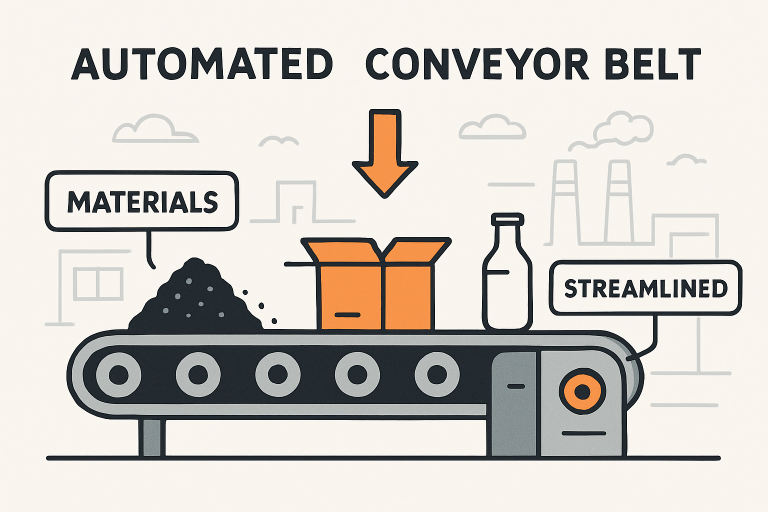In today’s fast-paced industrial landscape, conveyor belt systems boost efficiency and productivity. Their ability to streamline the movement of materials has transformed sectors as diverse as automotive assembly and food processing. Many businesses use specialized equipment and services—such as wire rope sling near me—to complement their conveyor setups when searching for reliable material handling solutions.
Conveyor belts have become a cornerstone of operational success, minimizing manual labor, enhancing output, and increasing workplace safety. Adaptable to different environments and industries, they are continuously evolving to meet the growing demands for automation and sustainability.
Enhancing Productivity Through Automation
One of the primary advantages of conveyor belt systems is the automation of repetitive and labor-intensive tasks. By reducing the need for manual material movement, these systems accelerate operations, reduce workplace injuries, and diminish the likelihood of errors. The automotive sector, for example, relies heavily on automated conveyors to ensure just-in-time delivery of parts to the assembly line. This guarantees a smooth workflow and minimizes costly production delays. The move toward fully automated supply chains pushes manufacturers to adopt sophisticated conveyor solutions that meet rising consumer demands and tighter delivery schedules.
Integration with Smart Technologies
Conveyor systems are no longer just mechanical tools—they have evolved into integrated platforms powered by innovative technology. Sensors and IoT (IoT) connectivity are standard in many modern conveyor installations. These enhancements enable real-time data collection, which supports predictive maintenance by signaling when components require servicing before failures occur. As a result, companies experience less downtime and extend the lifespan of their equipment.
Beyond maintenance, artificial intelligence and machine learning are now utilized to optimize conveyor performance. AI algorithms analyze production volumes, material types, and workloads, making real-time adjustments to conveyor speeds and load distribution. This improves efficiency and reduces wear on mechanical components, further driving down operating costs.

Advancements in Materials and Design
Material science innovations have contributed substantially to the durability and efficiency of conveyor belt systems. Using lightweight, high-strength polymers increases the lifespan of belts while reducing the energy required for movement. Special coatings and optimized surface textures minimize friction, lowering energy consumption and reducing wear on moving parts.
These advancements make conveyor systems more adaptable to various environments, from highly sanitized conditions in food production to the harsh climates in mining operations. The focus on improved design also enhances noise reduction and ease of maintenance, making conveyor systems more user-friendly and environmentally responsible.
Applications Across Various Industries
Conveyor belt systems find essential applications in a wide range of industries. Their versatility and scalability make them a popular choice for:
- Manufacturing: Seamless integration into assembly lines for the efficient transfer of parts and subassemblies, driving higher production rates and improved quality control.
- Food and Beverage: Hygienic materials and automated processes ensure the safe handling, sorting, and packaging of food products.
- Logistics and Warehousing: Streamlined movement and sorting of parcels reduces handling times and increases throughput in fulfillment centers and distribution hubs.
- Mining: Heavy-duty conveyor systems provide the backbone for transporting extracted materials across long distances, minimizing reliance on fuel-powered transport vehicles and enhancing overall cost-efficiency.
Energy Efficiency and Sustainability
Energy efficiency has become a top priority in conveyor system design with rising energy costs and increased environmental regulations. Including high-efficiency motors, variable-frequency drives, and regenerative braking systems has significantly reduced electricity consumption. These innovations not only lower operating costs but also contribute to sustainability goals.
Additionally, many belt manufacturers now use recycled or recyclable materials in their products, supporting a circular economy approach. Combined with designs that facilitate quick replacement of worn-out parts, these advancements help reduce industrial operations’ environmental footprint.
Future Trends in Conveyor Belt Technology
Rapid developments in digital automation and environmental stewardship shape the future of conveyor belt systems. Industry experts are forecasting the rollout of autonomous conveyor systems equipped with advanced AI for decision-making, adaptive routing, and load balancing. Efforts to incorporate biodegradable and fully recyclable materials into belt construction are also gathering pace, aligning with global sustainability initiatives.
Real-time analytics powered by machine learning will continue to improve decision-making, detect anomalies, and facilitate seamless system integration. These technologies position conveyor systems as key contributors to the next generation of smart factories and sustainable supply chains.
Conclusion
Conveyor belt systems have fundamentally changed how industries approach manufacturing, logistics, and materials management. By integrating automation, innovative technology, and advanced engineering, these systems consistently drive productivity, safety, and sustainability improvements. As innovation continues, conveyor belts will remain crucial to achieving new standards of operational excellence.
